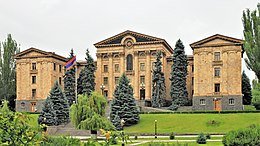Armenia's Parliament
|
National Assembly Ազգային ժողով, ԱԺ Azgayin Zhoghov |
|
|---|---|
 |
|
| Type | |
| Type | |
| History | |
| Founded | 5 July 1995 |
| Preceded by | Supreme Soviet of the Armenian SSR |
| Leadership | |
|
Vice-Presidents
|
|
|
|
|
|
|
|
| Structure | |
| Seats | 105 |
 |
|
|
Political groups
|
Government (65)
Opposition Parties (40) |
| Elections | |
| Semi-proportional representation with majority bonus system | |
|
Last election
|
2 April 2017 |
|
Next election
|
2022 |
| Meeting place | |
 |
|
|
National Assembly Building 19 Baghramyan Avenue Yerevan, 0095 Republic of Armenia |
|
| Website | |
| National Assembly of Armenia | |
Government (65)
Opposition Parties (40)
The National Assembly of the Republic of Armenia (Armenian: Հայաստանի Հանրապետության Ազգային ժողով, Hayastani Hanrapetyut'yan Azgayin zhoghov or simply Ազգային ժողով, ԱԺ Azgayin Zhoghov, AZh), also informally referred to as the Parliament of Armenia (խորհրդարան, khorhrdaran) is the legislative branch of the government of Armenia.
Before 1995, It was referred to as the Supreme Council of Armenia and formerly known as the Supreme Soviet of the Armenian Soviet Socialist Republic under Soviet rule.
The National Assembly is a unicameral body. The National Assembly consists of at least 101 seats, but with additional seats allocated it may grow to about 200 seats in extremely rare cases. The current President of the National Assembly is Ara Babloyan.
According to a law adopted in 2016, parties need to pass a 5% threshold and coalitions 7% respectively to be included in the distribution of mandates.
The election system reserves 50% of votes cast in favor of each party to be distributed via party lists. Out of these, four mandates will be assigned to national minorities first of all (provided they are included on party lists). A party list can not include over 70% of representatives of the same sex and its every four consecutive entries shall include members of both sexes.
Another 50% of votes received by each party is distributed among their territorial lists submitted in 13 electoral districts.
If neither party wins over 50% of mandates, a second round of elections is held. After the first round, the two best-placed parties participate in the second round. All mandates received during the first round are preserved. The party that wins the second round is given an additional number of mandates to reach 54% of all seats.
If any party or coalition wins over two-thirds of the mandates in the first round of elections sufficient additional mandates will be distributed among all other parties to ensure that at least one-third of all seats are given to parties other than the winning one.
...
Wikipedia
